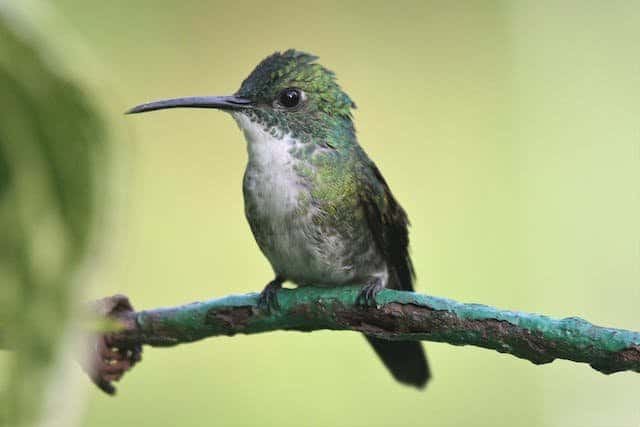Have you ever wondered What Do Hummingbirds Eat? Hummingbirds are among the most fascinating birds for their tiny size, incredible flying skills and vibrant colors. But what these little birds eat to fuel all that energy?
Hummingbird feeding habits are as diverse as they are impressive. These energetic creatures feed on a variety of food sources to meet their high metabolic needs, which includes nectar, insects, and tree sap. Let’s take a closer look at what hummingbirds eat and how they get their food.
Table of Contents
What Do Hummingbirds Eat? A Quick Look Step by Step:
Nectar – The Main Source of Energy:
Nectar is the primary source of energy for hummingbirds. Nectar contains high levels of sugars, mainly glucose and fructose, which provide hummingbirds with quick bursts of energy to sustain their rapid metabolism. They obtain nectar by feeding on the sweet, sugary liquid found in flowers. Hummingbirds are attracted to brightly colored flowers that produce large amounts of nectar, and their long, thin beaks are perfectly adapted for reaching deep into flower blossoms.
How Do Hummingbirds Collect Nectar:
Hummingbirds have a unique way of collecting nectar from flowers. Unlike bees, they do not have specialized mouthparts for sipping nectar. Instead, hummingbirds use their long, narrow beaks to insert into the flower and lap up the nectar with their tongues. Their tongues have split ends that help them collect nectar more efficiently. They can lick up to 13 times per second, allowing them to consume large amounts of nectar in a short period.
Insects – A Source of Protein and Fat:
While nectar provides hummingbirds with the necessary sugars for energy, they also need protein and fat to maintain their high metabolism. Hummingbirds get these essential nutrients from insects such as flies, gnats, spiders, and caterpillars. Insects make up about 10% of a hummingbird’s diet and are crucial for their survival, especially during breeding season.
How Do Hummingbirds Catch Insects:
Hummingbirds use their impressive flying skills to catch insects on the wing. They can hover in mid-air, fly backward and upside down, making it easier for them to snatch insects out of the air or off leaves. Their long, thin beaks also come in handy for catching insects hiding in tight spaces.
Tree Sap – A Sweet Treat:
In addition to nectar and insects, some hummingbird species also feed on tree sap. While not a significant part of their diet, hummingbirds may drink the sugary sap from holes made by woodpeckers or other birds in trees. This behavior is more common during the winter months when nectar sources are scarce.

The Specialized Diet of Hummingbirds:
While nectar, insects, and tree sap make up the majority of a hummingbird’s diet, some species have specialized feeding habits. For example:
- The Bee Hummingbird: This tiny bird feeds on flower nectar and also catches small insects with its long beak.
- The Sword-billed Hummingbird: With its exceptionally long bill, this hummingbird feeds on nectar from flowers with long corollas and also catches insects in flight.
- The Giant Hummingbird: This species has a diverse diet that includes nectar, insects, tree sap, and even small vertebrates like lizards and frogs.
What Is The Favorite Food Of Hummingbirds?
Nectar, insects, and tree sap make up the majority of a hummingbird’s diet, their favorite food is undoubtedly flower nectar. And with over 3000 species of flowers that produce nectar, there is no shortage of options for hummingbirds to choose from.
Do Hummingbirds Like To Eat Dirt?

No, hummingbirds do not eat dirt. They may accidentally ingest some while drinking from the ground or digging in it for insects, but they do not intentionally consume dirt as part of their diet. Eating dirt can be harmful to hummingbirds and should be avoided.
What Food Should Not to Serve Hummingbirds?
While hummingbirds have a diverse diet, there are certain foods that you should never offer them. These include:
- Honey: Honey can promote the growth of harmful bacteria and fungi in a hummingbird’s digestive system.
- Artificial sweeteners: These substances do not provide any nutritional value to hummingbirds and can be toxic.
- Red dye food coloring: The chemicals used in these dyes can be harmful to hummingbirds.
By avoiding these foods and providing a natural, well-maintained feeding environment, you can help keep hummingbirds healthy and happy.
The Handmade Food for Hummingbirds

While store-bought nectar is a convenient option for feeding hummingbirds, making your own homemade nectar can be a fun and rewarding experience. Here’s a simple recipe to make your own hummingbird food:
- Mix 1 part white granulated sugar with 4 parts of water.
- Boil the mixture for about 2 minutes and let it cool.
- Fill your feeder with the nectar and place it in a shady area.
It’s essential to remember not to add any dye or honey to the nectar as they can be harmful to hummingbirds. Also, avoid making large batches of nectar at once, as it can spoil quickly. Regularly clean and refill your feeder with fresh nectar.
The Hospitality of Feeding Hummingbirds
The hospitality of providing food for hummingbirds can create an enjoyable and peaceful experience for both humans and birds alike. So let’s protect these amazing creatures by providing them with the nourishment they need to thrive.
Overall, hummingbirds are fascinating creatures with unique diets and behaviors. By understanding what they eat and how to attract them, we can continue to enjoy their beauty in our gardens and help conserve these precious birds for future generations to appreciate.





